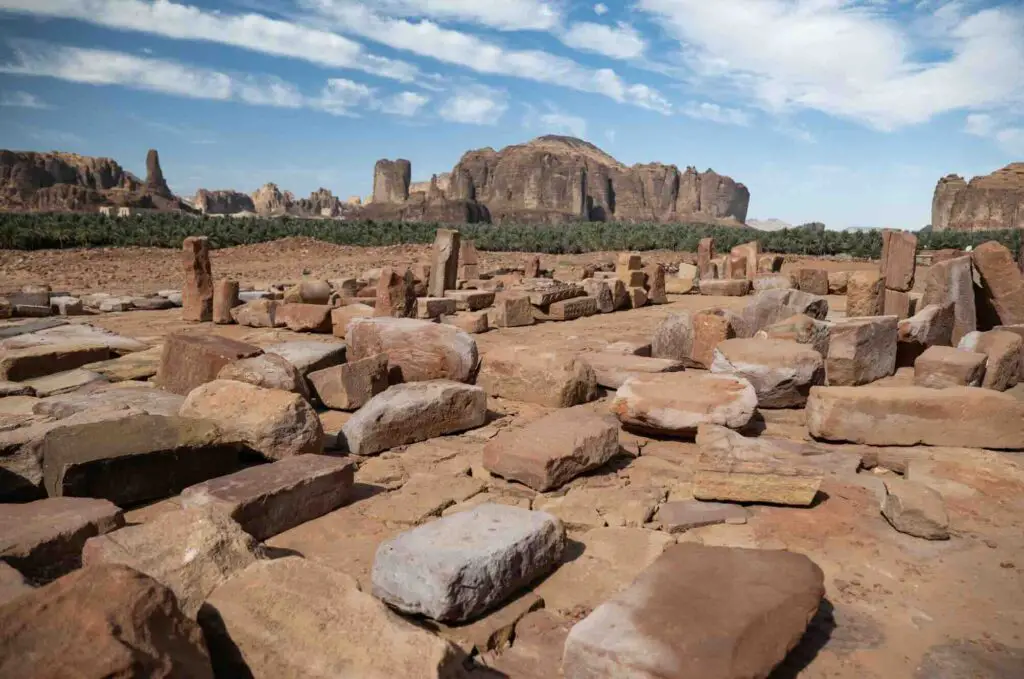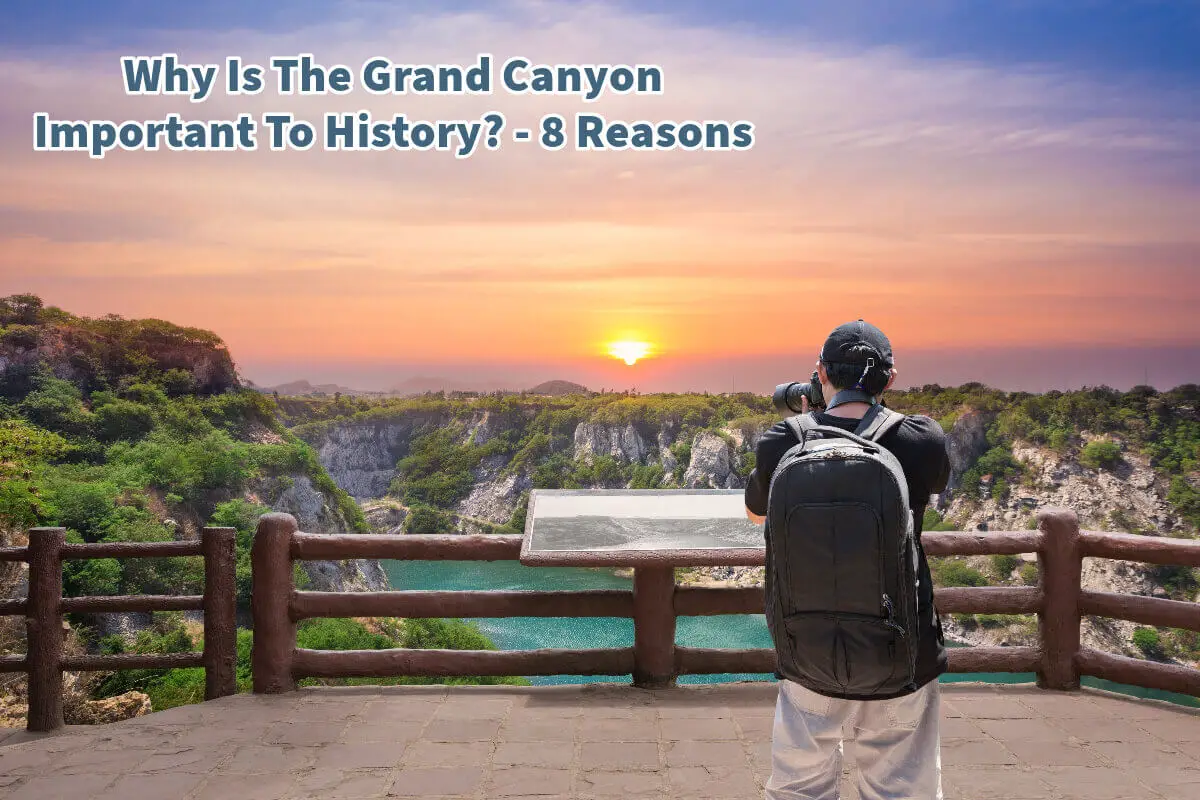The Grand Canyon, a breathtaking natural wonder, is often celebrated for its immense size, mesmerizing beauty, and geological significance. It is a place that is well worth visiting.
Yet, hidden within its layers and vast expanse lies a rich tapestry of history, particularly that of its native inhabitants. This history provides a depth of understanding that amplifies the canyon’s importance far beyond its visual grandeur. Read on as we explore how the Grand Canyon’s history is essential to understand.
Table of Contents
- Why The Grand Canyon Is Important To History? – 8 Interest Facts
- 8 Interesting Facts About The Grand Canyon History
- 1. The Grand Canyon Is A mile-Deep Gorge In Northern Arizona.
- 2. Scientists Estimate The Canyon May Have Formed 5 To 6 Million Years Ago, Showcasing The Oldest Exposed Rock On Earth.
- 3. The Rich Human History Of The Grand Canyon Dates Back To The Last Ice Age.
- 4. European Explorers First Set Eyes On The Grand Canyon In The 1540s.
- 5. The Journey From A Forest Reserve To A Renowned National Park.
- 6. A Catalyst For Conservation And Environmental Awareness
- 7. A Hub For Scientific Research And Discovery
- 8. The Grand Canyon In Modern Culture
- Related Questions
Why The Grand Canyon Is Important To History? – 8 Interest Facts
The Grand Canyon, renowned for its staggering magnitude and captivating beauty, is more than just a geological marvel. Within its layered depths and expansive contours is a woven narrative of history, especially the stories of its indigenous peoples.
This historical backdrop enriches our canyon comprehension, elevating its significance beyond mere visual awe.

8 Interesting Facts About The Grand Canyon History
1. The Grand Canyon Is A mile-Deep Gorge In Northern Arizona.
Standing as one of the world’s most awe-inspiring natural wonders, the Grand Canyon is a testament to the forces of nature. This mile-deep gorge in northern Arizona stretches over 277 miles in length and up to 18 miles in width. Its sheer scale is enough to boggle the mind and attract millions of visitors annually.
But beyond its breathtaking vistas, the Grand Canyon holds a treasure trove of secrets and stories that chronicle the Earth’s history and humanity’s relationship with this majestic land.
2. Scientists Estimate The Canyon May Have Formed 5 To 6 Million Years Ago, Showcasing The Oldest Exposed Rock On Earth.
The Grand Canyon is more than just a beautiful spectacle; it’s a geological time capsule. Scientists believe the process that formed this massive chasm began 5 to 6 million years ago. As the Colorado River meandered and cut its way through the landscape, it began excavating layers upon rock layers.
Some of the oldest exposed rock on our planet can be found within these layers, with the canyon’s walls revealing a cross-section of Earth’s crust dating back nearly two billion years. This offers geologists a rare opportunity.
By studying these layers, they can trace the evolution of the Earth through time, from the ancient Precambrian era to the more recent Paleozoic era. In a way, the Grand Canyon is a grand book of Earth’s history, with its layers telling tales of past environments, climates, and life forms.

3. The Rich Human History Of The Grand Canyon Dates Back To The Last Ice Age.
Humans, too, have found a home and history within the canyon’s vast walls. Since the last Ice Age, various indigenous groups have inhabited the region, starting with the Ancestral Pueblo people, followed by the Paiute, Navajo, Zuni, and Hopi tribes. Each left traces of their cultures, traditions, and stories etched into the very fabric of the canyon.
The Havasupai people hold a unique and deeply-rooted connection to the Grand Canyon, considering it their ancestral home. Their history tells of over 800 years of life in and around this majestic land. Yet, their bond with the canyon has faced challenges.
The formation of the Grand Canyon as a reserve and later as a national park resulted in the Havasupai losing almost all of their ancestral land. Only in 1975, after significant advocacy and media attention, did they regain a significant portion of their land from the federal government.
Today, the Havasupai blend tradition with modernity, leveraging the beauty of their homeland to drive tourism. The mesmerizing cerulean pools and iconic red rocks of Havasu Falls, situated in a secluded section of the Grand Canyon National Park, bring in approximately 20,000 visitors annually, forming a significant source of income for the tribe.
4. European Explorers First Set Eyes On The Grand Canyon In The 1540s.
While indigenous tribes had long known of the Grand Canyon’s majesty, the first Europeans to gaze upon its splendor were Spanish explorers in the 1540s. Their accounts painted a picture of a vast and formidable landscape, with tales of the canyon’s size and beauty returning to Europe.
Over the centuries, these stories would fuel curiosity, drawing explorers, settlers, and eventually tourists to experience the Grand Canyon for themselves.

5. The Journey From A Forest Reserve To A Renowned National Park.
Recognizing the unparalleled beauty and geological significance of the Grand Canyon, steps were taken to preserve it for future generations. President Benjamin Harrison 1893 designated the Grand Canyon as a forest reserve.
Yet, its acknowledgment as a national treasure came in 1919 when it was officially a United States National Park.
Today, the Grand Canyon stands as a symbol of nature’s grandeur and a testament to the intertwined histories of geology, indigenous cultures, exploration, and conservation. Its ancient and modern stories make it an invaluable gem in the tapestry of global history.
6. A Catalyst For Conservation And Environmental Awareness
The designation of the Grand Canyon as a national park in 1919 had broader implications than merely protecting a single natural wonder. It highlighted the burgeoning American conservation movement, which sought to preserve the nation’s most stunning and significant landscapes for future generations.
The Grand Canyon’s status as a national treasure galvanized efforts to safeguard other unique sites across the U.S., laying the groundwork for the modern National Park System that Americans cherish today.
Moreover, the Grand Canyon has continuously served as a poignant reminder of the delicate balance between human intervention and natural preservation. The controversies surrounding proposals like the construction of dams within the canyon in the 20th century were instrumental in pushing environmental awareness to the forefront of public consciousness.
7. A Hub For Scientific Research And Discovery
Beyond its aesthetic and historical importance, the Grand Canyon has long been a focal point for scientific exploration. Researchers from various disciplines flock to this natural laboratory to study its unique ecosystems, geological formations, and the effects of time and erosion.
The canyon offers invaluable insights into plate tectonics, sedimentary processes, and the history of life on Earth.
Moreover, its diverse habitats, ranging from arid desert to riparian zones along the Colorado River, host many plant and animal species, some of which are endemic to the region. Biologists and ecologists study these species to understand evolution, adaptation, and the intricacies of desert ecosystems.
8. The Grand Canyon In Modern Culture
Throughout the 20th and 21st centuries, the Grand Canyon has permeated popular culture. It has been the backdrop for countless films, novels, and television shows, symbolizing the American West’s rugged wilderness and the profound depth of human emotion and challenge.
Artists and photographers, inspired by its ever-changing hues and vast landscapes, have endeavored to capture its essence, further ingraining its image in the global imagination.
Furthermore, the canyon is often on many travelers’ bucket lists, drawing people worldwide. The tourism industry around the Grand Canyon, from river rafting adventures to scenic helicopter tours, has flourished, contributing significantly to the local economy and making it a cornerstone of Arizona’s identity.
The Grand Canyon’s importance to history cannot be overstated. It is a living testament to the Earth’s geological past, a repository of human history, and a beacon for conservation and scientific inquiry.
The Grand Canyon will inspire awe, curiosity, and reverence as we look ahead, reminding us of our small yet significant place within the vast tapestry of Earth’s story.
At A Bus On A Dusty Road, we talk about everything about travel, life, and ex-pat living. We are all about “Living Life As A Global Citizen.” We explore social, cultural, and economic issues and travel.
We would love to have you be part of our community. Sign up for our newsletter to keep up-to-date by clicking here. If you have any questions, you can contact me, Anita, by clicking here.
Listen to our Podcast called Dusty Roads. You can find it on all major podcast platforms. Try out to listen to one of our podcasts by clicking here.
Subscribe to our A Bus On A Dusty Road YouTube Channel with great videos and information by clicking here.
Related Questions
Is A Day Trip To The Grand Canyon Worth It?
If you only have one day to visit the Grand Canyon, it is still worth visiting. You can do things to prepare for your trip so that you will have the most time available. We recommend you go to see the South Rim area of the Canyon.
By clicking here, you can discover Is A Day Trip To The Grand Canyon Worth It?.
How Big Is The Grand Canyon? & Other Grand Canyon Questions
The Grand Canyon area is 277 miles long or about 1,904 square miles. It is a vast area that will take you 5 hours or 215 miles to travel from the North Rim to the South Rim of the Grand Canyon. Most of the area does not have hiking or other trails. As the Grand Canyon took about 6 million years to create, it is one of the world’s natural wonders.
By clicking here, you can discover How Big Is The Grand Canyon? & Other Grand Canyon Questions.
Was The Grand Canyon Once Totally Filled With Water? & More
The Grand Canyon was once filled with water, but the Grand Canyon itself is at least 6 million years old. The rock and rock formations of the Grand Canyon help us to tell the story of this magnificent place on earth.
By clicking here, you can discover Was The Grand Canyon Once Totally Filled With Water? & More.


